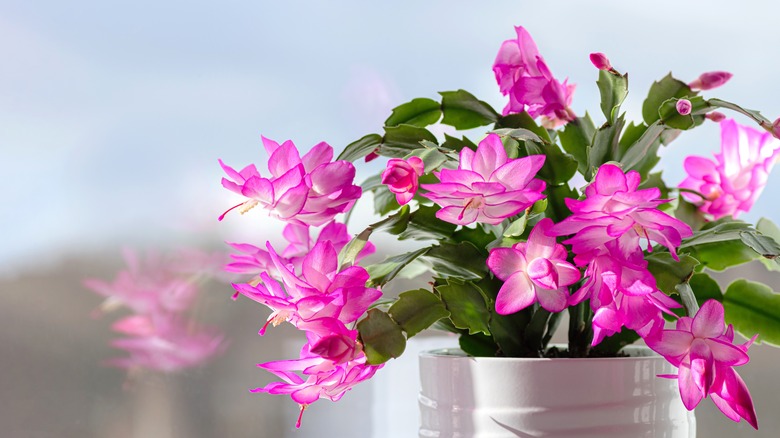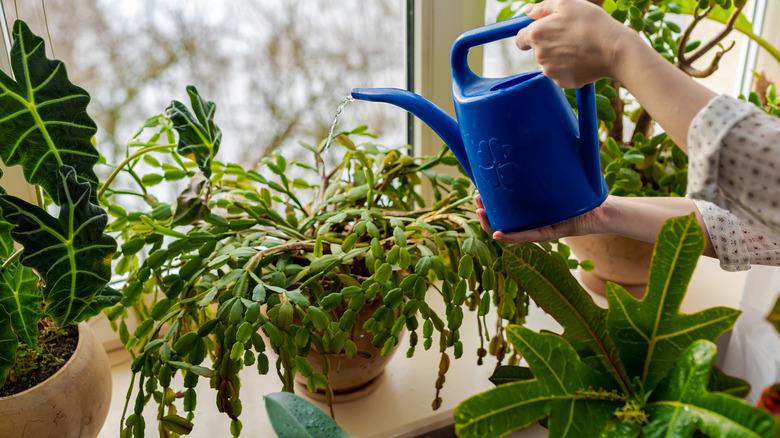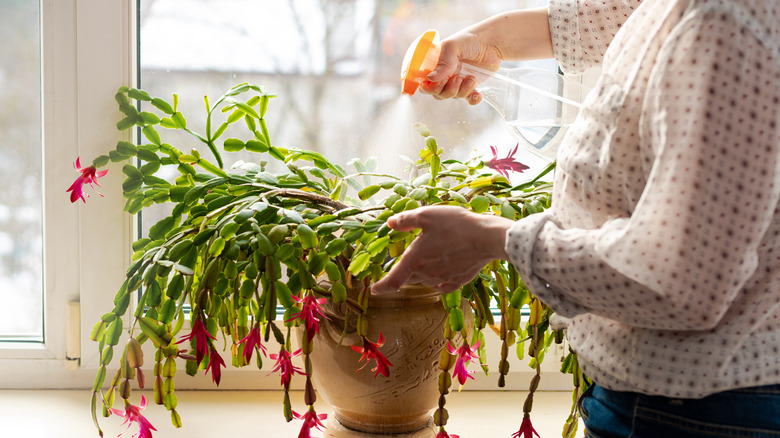Is Sugar Water The Key To A Happy And Healthy Christmas Cactus?
The Christmas cactus, scientifically known as Schlumbergera x buckleyi, is a succulent with flattened, segmented stems. Its distinctive appearance includes scalloped edges and vibrant, pendulous flowers that bloom in a range of colors. Renowned for its winter bloom, it graces indoor spaces with delicate, tubular flowers that emerge from the stem tips, adding a festive touch during the holiday season.
With an ability to adapt to various environments, this resilient plant offers beauty and charm, captivating enthusiasts with its stunning, long-lasting floral displays. Lately, on social media, the trend is to water these stunning succulents with sugar water to increase their vibrancy. This practice, however, is a mistake that could cost you your gorgeous winter blooms.
It's true sugar water can benefit certain houseplants by acting as a supplementary energy source. In instances where a plant faces stress, such as transplant shock or damage, a diluted sugar solution can provide a temporary boost. The sugar acts as a quick source of carbohydrates, potentially aiding in the stimulation of microbial activity in the soil, which may enhance nutrient availability. Moreover, for plants that engage in symbiotic relationships with certain microbes, the University of Minnesota acknowledges that sugar water can serve as a fuel source for these beneficial microorganisms, promoting a healthier root system and overall plant vigor. However, this watering method is not the best for the Christmas cactus.
Why to avoid sugar water for your Christmas cactus
Since plants naturally create their own sugars, it might seem like a good idea to use sugar water, but it is not advantageous for Christmas cacti specifically because of the plant's makeup.
First, the presence of sugar in water can disrupt the way the plant absorbs moisture, as well as upset the delicate balance of soil nutrients. Like most houseplants, Christmas cacti have evolved to absorb water and nutrients from the soil through their roots. Introducing sugar into the watering routine can interfere with this natural process. Sugars, when dissolved in water, create a hypertonic solution that could potentially draw water out of the plant's roots, affecting its ability to effectively absorb water. This disruption can lead to dehydration and nutrient deficiencies, ultimately harming the plant's health and impeding its growth and flowering potential.
Secondly, sugar water can create a favorable environment for microbial growth and pests. When sugar is added to water, it becomes a breeding ground for bacteria, fungi, and other microorganisms. These microorganisms can thrive in moist and sugary environments, increasing the risk of root rot and other fungal diseases in the Christmas cactus. Furthermore, the sweet solution might attract unwanted pests like ants, gnats, or even mold, which can further compromise the plant's health. Overall, the use of sugar water in watering Christmas cacti can inadvertently invite detrimental elements that pose a risk to the plant's overall well-being.
Other ways to help your Christmas cactus thrive
If you'd like to help your Christmas cactus thrive, skip the sugar water and emphasize other natural care routines that will help your plant grow healthily. First and foremost, providing the right light conditions is crucial. These cacti thrive in bright, indirect light but can tolerate some direct sunlight, especially in the winter months, according to Lowe's. Placing the cactus near an east or north-facing window ensures it will receive sufficient light without the risk of scorching from intense sun exposure. In summer, consider moving the plant to a shaded area outdoors where it can benefit from filtered sunlight. Consistency in light exposure is essential, especially when transitioning from season to season, as sudden changes can stress the plant.
Maintaining a proper watering routine is also key. Christmas cacti prefer slightly moist but well-draining soil. Overwatering can lead to root rot, while underwatering can cause wilting and hinder flowering. Water the plant thoroughly when the top inch of the soil feels dry to the touch, allowing excess water to drain away. During the blooming season, slightly increase the watering frequency but continue to avoid waterlogging. Adjust watering according to seasonal changes; they may require more water during active growth periods and less during dormancy.
Lastly, Christmas cacti appreciate moderate temperatures, ideally between 65-75°F. Avoid exposing them to extreme temperature fluctuations, such as drafts or sudden drops in temperature, as this can cause bud drop or stress the plant.


